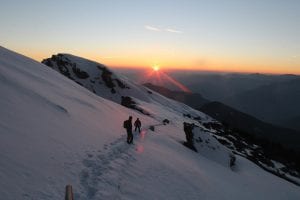It is the starting point for Tungnath trek and is the 3rd Kedar among 5 Kedar in Uttarakhand. Another 1.5 km trek from Tungnath head to Chandrashila(Altitude 4090 mts) which offers a panoramic view of snow-clad Himalayan peaks. The visible peaks are Chaukhamba, Trishul, Nanda Devi, Kedar Dome and many more (more than 60 peaks). This valley is part of Kedarnath Wildlife Sanctuary which is one of the richest wildlife sanctuaries in flora, fauna, and biodiversity in the world.
The valley Chopta, located approximately 200 km away, offers a scenic drive alongside renowned rivers such as the Ganga, Alaknanda, and Mandakini. A link road, recently designated as a national highway, winds its way through the Chopta region at an elevation of 2700 meters, connecting the Alaknanda (Badrinath) and Mandakini (Kedarnath) valleys.
Chopta’s accessibility is convenient from both valley sides, although the Mandakini side is closer and preferred by most tourists throughout the year. During the snowfall season, typically from December to March, the link road is closed, and tourists primarily access Chopta via the Mandakini (Kedar) valley. However, the government is now considering plans to keep the road open from both valley sides even during the snow season, thanks to the designation of the link road as a national highway.
Not only does every passing season but every month also leaves its incredible impact on the Chopta region’s entire environment. Rain is an essential part of the Chopta region, fulfilling the jungle’s significant water demand. It can rain here at any time, any week, and any month of the year. There are mainly six seasons in Chopta that anyone can easily observe: spring, summer, rainy, pre-winter, winter, including snowfall. In Chopta, every season has its own color, fragrance, feel, movement, and beauty, which keep changing month to month and season to season.
Spring Season:
In the spring season, the fragrance of Rhododendron flowers fills the whole atmosphere of Chopta because 20% of the forest is occupied by Rhododendron trees.
Summer Season:
Summer brings greenery, flowers, and lots of tourists to the Chopta valley. April, May, and June are the best times to visit Chopta for tourists of all ages because the temperature remains gentle and the weather mild.
Rainy Season:
Dense fog envelopes the entire Chopta region in July and August for two months. Usually, the advent of the snowfall season is expected after mid-December and lasts up to mid-March, but sometimes it might extend its time.
As Chopta is part of Kedarnath wildlife sanctuary, it is evident that there is an abundance of plants and animals in the area. With over 251 species of birds (both migrant and permanent), approximately 100 species of mammals, and 45 species of giant trees, along with countless varieties of flowers and insects, the biodiversity of Chopta is remarkable. Among these species, many are on the verge of extinction, such as the Musk deer, snow leopard, Monal, vultures, Thuner, Paapri, and Ghinaroo.
Furthermore, Chopta attracts many scientists and students who come to study its diverse and unique flora and fauna. At one point, the forest department even established a Musk deer sanctuary in Chopta with the aim of protecting and breeding Musk deer, but unfortunately, it was unsuccessful.
Local Population Chopta
Topography of Chopta-
Hotel /camps in Chopta-
Chopta Distance Chart-
ALSO VISIT CHOPTA TRAVEL PACKAGES


